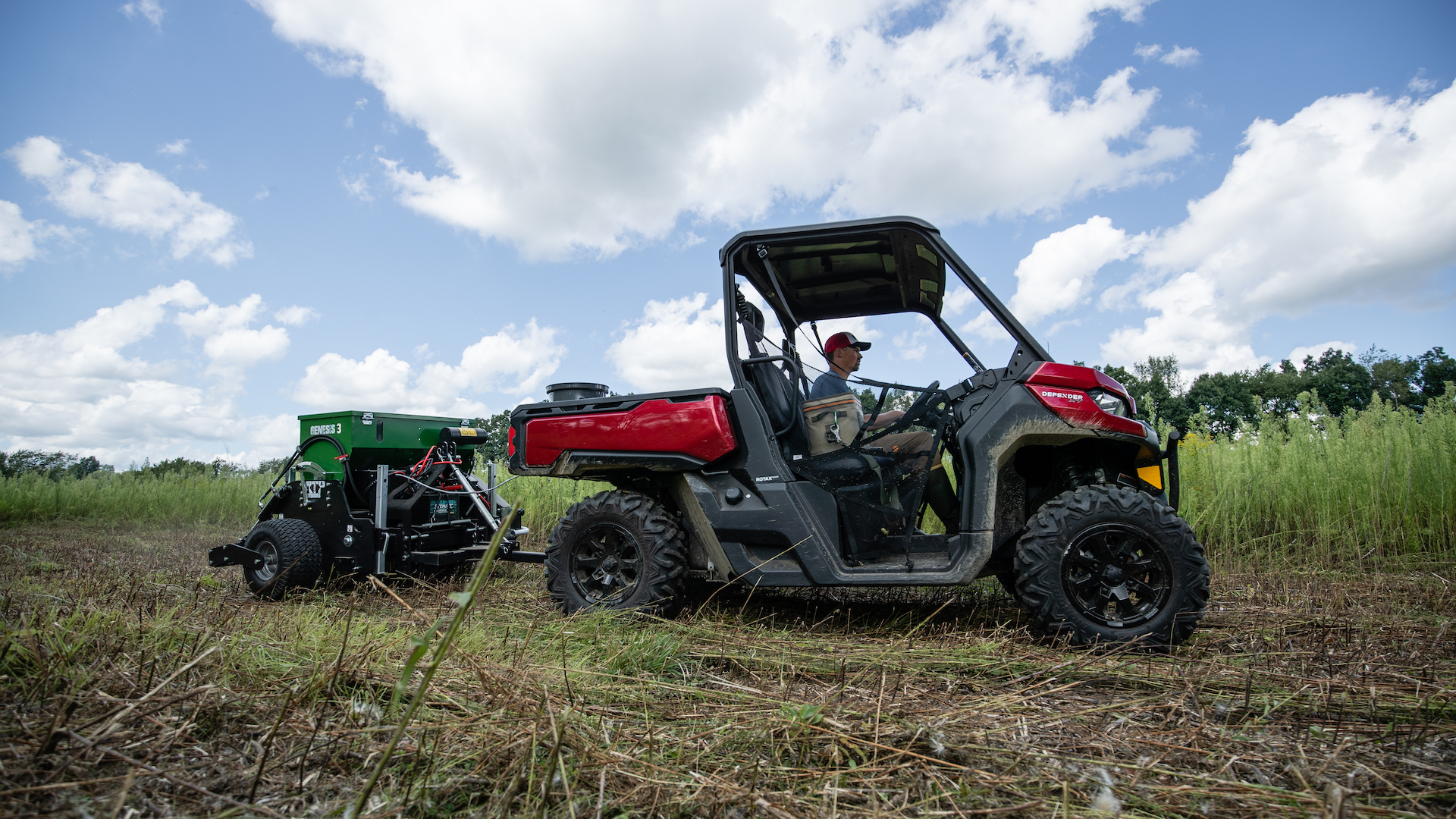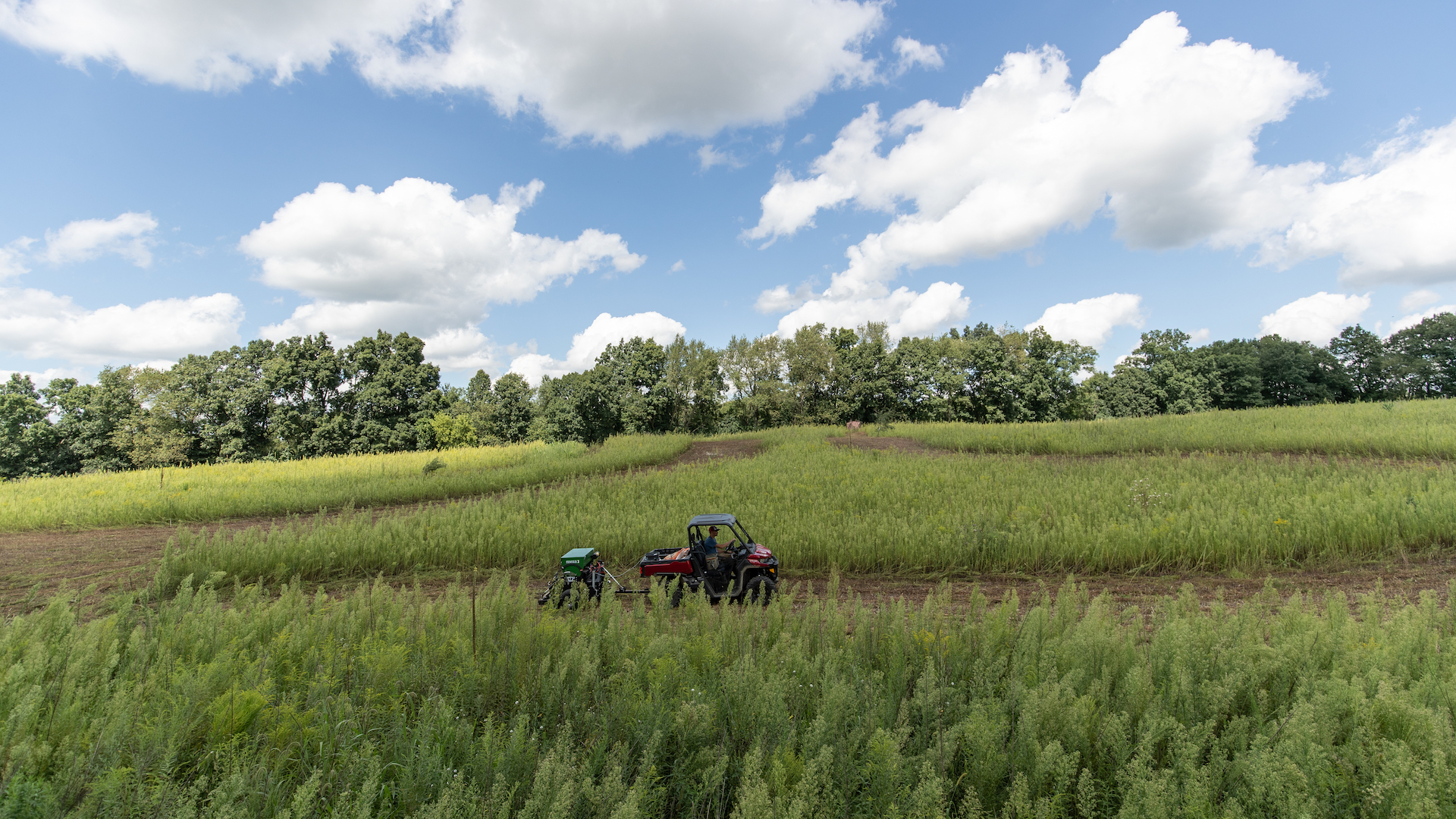
It’s possible that you’re needlessly wasting money on your whitetail food plots and damaging elements of your hunting property just as much, if not more than you’re helping. Got your attention? Let me explain.
Food plots are a proven means for providing high-quality wildlife forage and are an effective hunting tool. But it’s also true that traditional food-plotting practices can negatively impact your soil health, water quality, and surrounding native vegetation—not to mention your checking account. If you’re planting food plots to help wildlife and the local ecosystem, traditional food-plot practices leave something to be desired. Fortunately, there’s more than one way to skin this cat, and a potential solution lies in the commercial farming industry.
A relatively new but rapidly growing practice known as “regenerative agriculture” is sweeping America’s farm country, and with it lies the potential for a new and more beneficial way of planting food plots. Here’s a look at why whitetail land managers might want to adopt a regenerative agriculture philosophy and how you can use these simple but profound principles to produce thriving food plots with less money, time, and adverse impacts.

What is Regenerative Agriculture and Why It Makes Sense for Food Plots
The land we use to farm and create food plots is not merely a lifeless expanse of dirt but rather a living, breathing ecosystem managed by complex biological processes. A handful of healthy soil is full of microbes, fungi, bacteria, and earthworms all working together to create the nutrients and setting necessary for plant life while also serving numerous other purposes for the larger ecosystem around it.
Healthy soil covered in a diverse array of vegetation creates its own plant-growing fertilizer, sequesters carbon, better retains moisture, filters water, and reduces soil erosion. The traditional food plot routine of regularly spraying herbicide, tilling the soil, and dumping chemical fertilizers sabotages these natural processes. Regenerative agriculture, on the other hand, harnesses these earth-made mechanisms to retain and create healthier soil that produces a healthy crop with less fertilizer, herbicide, and time.
“We're trying to create a more resilient system, both from an ecological standpoint, but also from a financial standpoint,” Jason Snavely said on the Wired to Hunt Podcast. “It's really about trying to mimic those natural processes and those natural systems that are already in place and trying to work with them instead of trying to dominate them."
So how do we do this?

Putting Regenerative Agriculture Into Action
To get a better sense of how we can apply this philosophy to food plots, let’s explore a few of the most relevant principles of soil health as defined by Gabe Brown, author of “Dirt to Soil” and regenerative agriculture expert.
Limit Disturbance
A foundational premise of regenerative agriculture is that the disturbance of soil—whether physically or chemically—reduces soil health and the long-term productivity of the land. Brown explains that when a farmer, or food plotter, repeatedly discs or tills up soil it is effectively “tearing apart the house that nature builds to protect the living organisms in the soil that create natural fertility.”
Professional soil scientist Ray Archuleta puts it in even more stark terms. “Tillage is like taking a wrecking ball to your soil. You're breaking up the aggregates, destroying the pores, and compacting the soil. This leads to reduced water infiltration, increased runoff, and decreased nutrient availability.”
Chemical disturbance, in the form of synthetic fertilizers and herbicides, should be minimized as well. These chemicals, while ostensibly used to improve crop production, disrupt the processes that naturally build soil and cost a pretty penny too. If that’s not enough, spray drift from off-label use of herbicides has been shown to negatively impact important pollinator habitat and over-applied fertilizer routinely runs off into creeks, rivers, and lakes leading to toxic algal blooms.
How to Limit Disturbance on Your Food Plot
Fortunately, there are plenty of alternative approaches to food plot site prep that avoid or reduce these forms of disturbance. Rather than using a disc or roto-tiller to cultivate your food plots, consider using a no-till drill. Instead of tearing apart the ground, these drills cut a thin line in the soil, drop a seed into the divot, cover it, and press the soil down above. No-till planting practices have stormed the farming world in recent decades, and a number of wildlife-management-focused companies are already producing implements for hunters. Many local conservation districts have no-till drills available for rent as well.
There are numerous ways to no-till plant without a drill as well, such as frost seeding and other broadcast-focused planting styles that involve seeding into a standing crop of vegetation prior to a rain, terminating the weed growth, and then achieving germination with the help of the dead thatch layer laying overtop the seeds.
While herbicide use might still be necessary at certain phases of food plot prep or management, it’s recommended to minimize this practice as much as possible. For more on herbicide best practices and alternatives, read “4 Eco-Friendly Ways to Manage Food Plot Weeds.”
Armor Your Soil and Keep Living Roots
The next step to planting crops in a regenerative fashion is to ensure that your soil is covered and fosters living root systems year-round. “Bare soil is an anomaly,” Brown said. “Nature always works to cover soil. Providing a natural coat of armor protects soil from wind and water erosion while providing food and habitat for macro- and microorganisms.” Similarly, the year-round, living roots that come with keeping the surface armored provide the nutrients needed to nurture soil biology throughout the entire year.
How to Armor Your Food Plot Soil and Keep Living Roots
The simplest way to do this is by planting food plots that include perennial species. This not only builds soil year-round but also suppresses the growth of undesirable weed species and prevents erosion.
Crops such as clover are attractive to whitetails, require minimal maintenance, and can last well over five years with one planting. If you’re looking to plant annual plots like brassicas or grains, you might consider a rotation program in which you plant one food plot early in the spring that suppresses warm-season weeds and builds soil fertility in the off-season. Then, plant a fall blend over top of it at the end of summer to focus on attracting deer for hunting season.
Jeff Sturgis, of Whitetail Habitat Solutions, has popularized one method of doing this by planting early spring buckwheat, which he then terminates at the end of summer and over-seeds with a more attractive hunting-focused blend. Dr. Grant Woods, of Growing Deer, has popularized another version of this that he refers to as the Buffalo Food Plot or “Release Process.”
Diversity
Monocultures almost never occur in the natural world. Instead, we see diversity everywhere life thrives. Regenerative agriculture applies this same concept to the crops we plant. By planting a diverse blend of species in your plot, you achieve several benefits, including a reduced risk of complete crop failure. If one species in your blend lacks the nutrients, conditions, or water needed to grow, it’s likely that other species in the blend will still be able to persist. Throw enough darts at the board, and at least a few will stick, even in adverse conditions.
Even more importantly, diverse plant species grown together can actually collaborate to better utilize the resources at hand. “Grasses, forbs, legumes, and shrubs all live and thrive in harmony with each other,” Brown said. “Think of what each of these species has to offer. Some have shallow roots, some deep, some fibrous, some tap. Some are high-carbon, some are low-carbon, some are legumes. Each of them plays a role in maintaining soil health.”
For example, look at how a simple blend including clover and turnips might be able to work together. Clover is a legume that pulls nitrogen, an incredibly important fertilizing agent, from the atmosphere and transfers it into the soil. A neighboring turnip plant can utilize that nitrogen to grow to its fullest potential and then grow a large bulb that aerates the soil and eventually returns significant organic matter back into the ground. That organic matter will feed the clover the following spring as it emerges from dormancy, and the cycle begins again. All of this means that your plants can work together to provide the nutrition they need themselves, rather than depending on you to supplement with synthetic fertilizers that cost you money.
How to Implement Diversity on Your Food Plot
This one is easy. Avoid planting single-species food plots. Blended food plots not only provide the benefits mentioned above but also sustain a longer period of attraction to deer as different species come in and out of palatability throughout the year. Deer might visit your plot in September to feed on oats, key in on clovers in October, keep visiting in January for the brassicas, and then come through again in spring as your clover pops again. Fall blends, with a deer-attracting focus, might incorporate several types of clover, wheat, rye, oats, turnips, rape, sugar beets, triticale, and winter peas.
On the other hand, for those planting a blend in the spring primarily focused on soil building, a blend might include species that provide more organic matter and fix more nitrogen such as sunn hemp, buckwheat, sunflowers, soybeans, and sorghum. Companies like Vitalize Seed, Green Cover Seeds, and Drop Tine Seed Company all produce mixes along these lines developed specifically for wildlife food plots in line with regenerative ag principles.

Collaborating with Earth
I’ve heard it said that regenerative agriculture is akin to the art of repairing ecosystems. If this is true, then we land managers have at our fingertips an opportunity to create a masterpiece. Rather than tearing down the house Mother Earth built in our effort to create better hunting, we can partner with soil, water, and sun to not only feed wildlife but also rebuild the land we steward from the ground up. So what are you waiting for?





